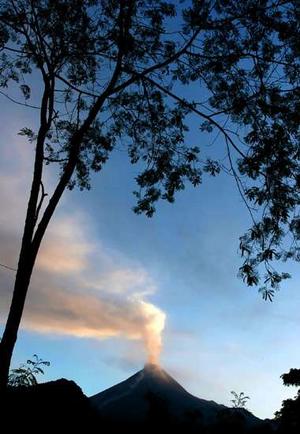
Publisher:
Bonnie King
CONTACT:
Newsroom@Salem-news.com
Advertising:
Adsales@Salem-news.com

~Truth~
~Justice~
~Peace~
TJP
May-28-2006 22:30

 TweetFollow @OregonNews
TweetFollow @OregonNews
Indonesian Quake Death Toll Passes 4,300
By CHRIS BRUMMITT, Associated Press Writer
 Mount Merapi, seen from a village near Yogyakarta Saturday Photo: AP |
(BANTUL, Indonesia) - After sleeping outside in streets and fields, Indonesian earthquake survivors scavenged their wrecked villages Sunday for food, clothing and anything of use as the death toll rose to more than 4,300. Some 200,000 people were left homeless.
Waves of aftershocks compounded the terror of the magnitude-6.3 quake, which flattened villages and towns on densely populated Java island early Saturday — Indonesia's worst disaster since the 2004 tsunami. Power and phone service remained out amid fears that a nearby rumbling volcano might erupt.
Nations worldwide hurried to send food, supplies and funds. The Rome-based U.N. World Food Program said a plane with medicine and medical personnel was en route, as were eight truckloads of fortified noodles and biscuits. The U.N. children's agency UNICEF said it was ready to send tents, hygiene kits, health kits and school supplies.
The worst devastation was in the town of Bantul, which accounted for three-quarters of the deaths. One man dug his 5-year-old daughter out of the rubble of her bedroom only to have her die in a hospital awaiting treatment with hundreds of others.
"Her last words were 'Daddy, Daddy,'" said Poniran, who like many Indonesians uses only one name.
"I have to start my life from zero again."
Some bodies were pulled from the collapsed brick-and-wood houses early Sunday in villages visited by reporters, but few were believed to still be trapped. Most of the dead were buried within hours of the disaster, in line with Islamic tradition.
In Peni, a hamlet on Bantul's southern outskirts, 20 residents searched for a neighbor, Purwoko, after finding the bodies of his wife and three children. Villagers set up simple clinics despite shortages in medicine and equipment. Women cooked catfish caught in a nearby pond for dozens of people huddled under a large tent.
The quake hit hundreds of square miles of mostly farming communities in Yogyakarta province, causing damage to the world-famous 9th century Prambanan temple. As many as 450 aftershocks followed, the strongest magnitude 5.2.
At least 4,332 people were killed, according to government figures, and the International Federation of Red Cross and Red Crescent said at least 200,000 people were left homeless.
Many people spent Saturday night sleeping in any open space available — on streets, in cassava fields, in narrow rice groves. On Sunday, exhausted and grieving, survivors searched the ruins of their homes and complained that aid was slow in arriving.
"We're short of everything — clothes, food, water, all are gone. We are poor people, but our lives still matter," said Budi Wiyana, 63. Doctors struggled to care for the injured, hundreds of them lying on plastic sheets, straw mats and even newspapers outside overcrowded hospitals. Some were hooked to intravenous drips dangling from trees.
Bloodstains littered the floor at Yogyakarta's Dr. Sardjito Hospital, along with piles of soiled bandages and used medical supplies. Relatives fanned victims in the heat in temporary shelters set up in the parking lot and corridors.
"We have too many patients and they're still arriving," said Aru, a doctor, adding that the hospital had received more than 2,000 wounded.
The earthquake hit at 5:54 AM, caving in tile roofs and sending walls crashing down. Survivors screamed as they ran from their homes, some clutching bloodied children and the elderly.
The quake was the latest in a series of disasters to hit Indonesia: The 2004 tsunami that killed 131,000 people in Aceh province, terrorist attacks, a widening bird flu outbreak, and the threat of eruption from nearby Mount Merapi.
The quake's epicenter was 50 miles south of the volcano, and activity increased soon after the temblor. A large burst spewed hot clouds and sent debris cascading some two miles down its western flank. No one was injured because nearby residents had already been evacuated.
Officials said the famed 7th century Borobudur Buddhist temple, one of Indonesia's most popular tourist attractions, was not affected. But Prambanan, a spectacular Hindu temple to the southeast, suffered serious damage, with hundreds of stone carvings and blocks scattered around the ancient site.
It will be closed to the public until archeologists are able to determine whether the foundation was damaged, said Agus Waluyo, head of the Yogyakarta Archaeological Conservation Agency. Close to 1 million tourists visit the Borobudur and Prambanan temples every year.
International agencies and nations across Europe and Asia pledged millions of dollars in aid and prepared shipments of tents, blankets, generators, water purification equipment and other supplies. The United States promised $2.5 million in emergency aid; the European Union granted $3.8 million.
Articles for May 27, 2006 | Articles for May 28, 2006 | Articles for May 29, 2006

Quick Links
DINING
Willamette UniversityGoudy Commons Cafe
Dine on the Queen
Willamette Queen Sternwheeler
MUST SEE SALEM
Oregon Capitol ToursCapitol History Gateway
Willamette River Ride
Willamette Queen Sternwheeler
Historic Home Tours:
Deepwood Museum
The Bush House
Gaiety Hollow Garden
AUCTIONS - APPRAISALS
Auction Masters & AppraisalsCONSTRUCTION SERVICES
Roofing and ContractingSheridan, Ore.
ONLINE SHOPPING
Special Occasion DressesAdvertise with Salem-News
Contact:AdSales@Salem-News.com


Salem-News.com:

Terms of Service | Privacy Policy
Comments are Closed on this story.
[Return to Top]
©2025 Salem-News.com. All opinions expressed in this article are those of the author and do not necessarily reflect those of Salem-News.com.